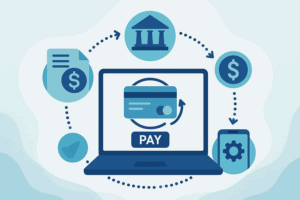
A great business idea isn’t enough — you need a creative strategy to bring it to life. A creative strategy is a detailed plan outlining how you’ll achieve your business goals while standing out from competitors.
It’s about thinking differently, appealing to customers in unexpected ways, and ensuring your brand stays relevant. Whether you’re launching a new product, rebranding, or looking to grow, a strong creative strategy keeps you on track.
This guide will walk you through key steps, from defining your goals to crafting the right messaging to outsmart competitors and make a lasting impact.
What is Creative Strategy?
A creative strategy is your business’s game plan for attracting and engaging customers in a way that sets you apart. It combines clear objectives, market insights, and innovative ideas to create a unique brand presence.
Whether you are in retail, professional services, or tech, a creative strategy guides decisions, making marketing efforts more effective and cohesive. Many businesses collaborate with a creative agency to refine their approach, giving them the edge they need.
How to Put Together a Creative Strategy
Building a creative strategy involves a few key steps. Begin by defining your business goals.
Key question: “What do you want to achieve?
Next, craft a clear strategy statement that outlines your brand’s unique value.
Then, determine how you’ll measure success — what key performance indicators (KPIs) will show that your strategy is working? Competitive analysis is also crucial; you must understand what your rivals do to stand out.
Finally, define your target audience, including their preferences, pain points, and behaviours.

Define Your Goals
Every strong creative strategy starts with clear goals. Without them, you’re just throwing ideas at the wall and hoping something sticks. Are you looking to increase brand awareness, boost sales, or improve customer retention?
Be specific — saying “I want more customers” is too vague. Instead, aim for something measurable, like “I want to increase online sales by 20% in six months.” Your goals should be SMART (Specific, Measurable, Achievable, Relevant, and Time-bound).
Think about how your business can stand out in a crowded market. For example, if competitors focus on price, maybe your strategy highlights premium quality or personalised service.
Write a Creative Strategy Statement
A creative strategy statement summarises your plan in a simple, actionable way. It should answer three key questions:
- Who is your target audience?
- What makes your brand different?
- How will you communicate your uniqueness?
For example, if you own a boutique coffee shop, your statement might be: “We target professionals who value high-quality, ethically sourced coffee. We provide a personalised experience in a welcoming environment, building customer loyalty through storytelling and community engagement.”
The clearer your strategy statement, the easier it is to develop campaigns, ads, and content that align with your business identity and customer expectations.
Choose Your Success Metrics
How do you know if your creative strategy is working? By choosing the right success metrics.
Metrics help track progress and indicate whether you’re reaching your goals. Tools like Google Analytics, Facebook Insights, or CRM reports can help.
If your strategy focuses on brand awareness, track website traffic, social media engagement, and customer inquiries.
If you’re aiming for higher sales, monitor conversion rates and revenue growth.
Customer satisfaction can be measured through reviews, surveys, or repeat purchases.
The key is to choose measurable indicators that align with your goals.
For example, if you’re running an online ad campaign, clicks and conversions matter more than impressions. Regularly reviewing these metrics allows you to refine your strategy, making data-driven adjustments to improve results over time.

Conduct Competitor Analysis
To outshine competitors, you first need to understand them. Competitor analysis helps you see what others are doing well and where they fall short, giving you an edge. Identify your top competitors—who are they, and what’s their market positioning?
Analyse their branding, messaging, customer reviews, and marketing tactics. What’s working for them? What gaps can you fill?
Tools like Google Trends, SEMrush, and SWOT (Strengths, Weaknesses, Opportunities, Threats) analysis can provide a clearer picture. Social media insights and customer feedback can also provide valuable data.
The goal isn’t to copy but to differentiate— to find unique ways to appeal to customers your competitors haven’t considered.
Determine Your Messaging and Target Audience
Who are you talking to, and what do you want to say? Be specific—your audience isn’t “everyone.” Create buyer personas (e.g., “Busy parents who value convenience”) to tailor your messaging.
What challenges do they face, and how does your product or service solve them? A family-owned bakery may target health-conscious parents looking for organic treats, while a financial consulting firm may cater to young professionals seeking investment advice.
Decide on tone: friendly, authoritative, quirky? Your voice should reflect your brand and resonate with your audience.
Next, craft key messages that highlight your unique value. It should be clear, consistent, and unique. Test different angles—sometimes, the message you love isn’t what clicks with customers. Focus on benefits rather than features.
Set a Budget and Timeline
A creative strategy is only as effective as the resources behind it. Setting a budget ensures you allocate funds wisely, balancing creativity with practicality. Determine how much you can spend on marketing efforts like social media ads, content creation, or influencer collaborations.
Break down costs—what percentage will go toward paid advertising, branding, or website development? Having a clear budget prevents overspending and keeps your strategy focused.
Alongside budgeting, establish a realistic timeline. Are you launching a campaign in six months, or is this an ongoing effort?
Set milestones to track progress, such as completing a website redesign in three months or hitting 10,000 social media followers by year’s end.
Blending a creative strategy into your business plan is essential for staying competitive and engaging your audience. You can create a clear strategy that sets you apart by clearly defining your goals, understanding your market, and crafting targeted messaging. It’s not just about thinking outside the box—it’s about aligning your creative approach with your business objectives.















